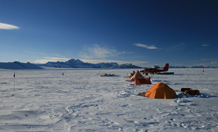
The British Antarctic Survey’s Twin Otter survey plane & camp, the plane was used to collect data about the size of the sub-ice-shelf channel. Image credit Neil Ross.
Giant channels discovered beneath Antarctic ice shelf
The 250 metre high channels will help predict future of Antarctic ice.
Scientists have discovered huge ice channels beneath a floating ice shelf in Antarctica. At 250 metres high, the channels are almost as tall as the Eiffel tower and stretch hundreds of kilometres along the ice shelf.
The channels are likely to influence the stability of the ice shelf and their discovery will help researchers understand how the ice will respond to changing environmental conditions.
Researchers from the University of Exeter, Newcastle University, the University of Bristol, the University of Edinburgh, the British Antarctic Survey and the University of York, used satellite images and airborne radar measurements to reveal the channels under the ice shelf. The channels can be seen on the surface of the ice shelf, as well as underneath, because the ice floats at a different height depending on its thickness.
The researchers also predicted the path of meltwater flowing under the part of the ice in contact with the land – known as the ice sheet. They discovered that the predicted flow paths lined up with the channels under the ice shelf at the point where the ice starts to float.
The match-up indicates that the water flow beneath the grounded ice sheet is responsible for the formation of the channels beneath the floating ice shelf. When the meltwater flowing under the ice sheet enters the ocean beneath the ice shelf, it causes a plume of ocean water to form, which then melts out the vast channels under the ice shelf. Previously, it was thought that water flowed in a thin layer beneath the ice sheet, but the evidence from this study suggests it flows in a more focussed manner much like rivers of water. The way in which water flows beneath the ice sheet strongly influences the speed of ice flow, however, the implications for the future of the ice sheet are yet to be determined.
Dr Anne Le Brocq from the University of Exeter said: “If we are to understand the behaviour of the ice sheet, and its contribution to changes in sea level, we need to fully understand the role of water at the base of the ice sheet. The information gained from these newly discovered channels will enable us to understand more fully how the water system works and how the ice sheet will behave in the future.”
Channels of this magnitude have been observed before elsewhere, but their formation has been attributed to purely oceanic processes rather than meltwater exiting the grounded ice sheet. Now, with the connection to the meltwater system established, readily obtainable observations from the channels have the potential to shed light on how meltwater flows at the base of an inaccessible kilometre-thick ice sheet. The study received funding from Natural Environment Research Council (NERC) and the European Space Agency (ESA).
The research is published in the journal Nature Geoscience.
Date: 6 October 2013
